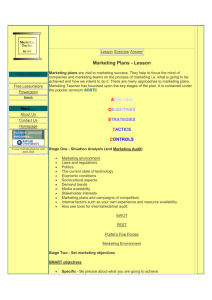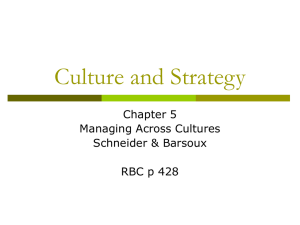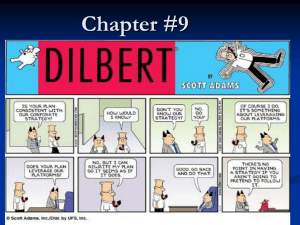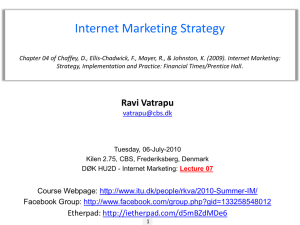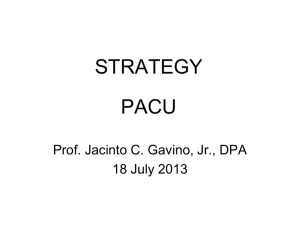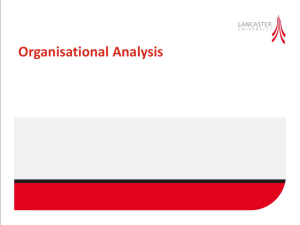Business Policy – determination of the long term goals of an
advertisement
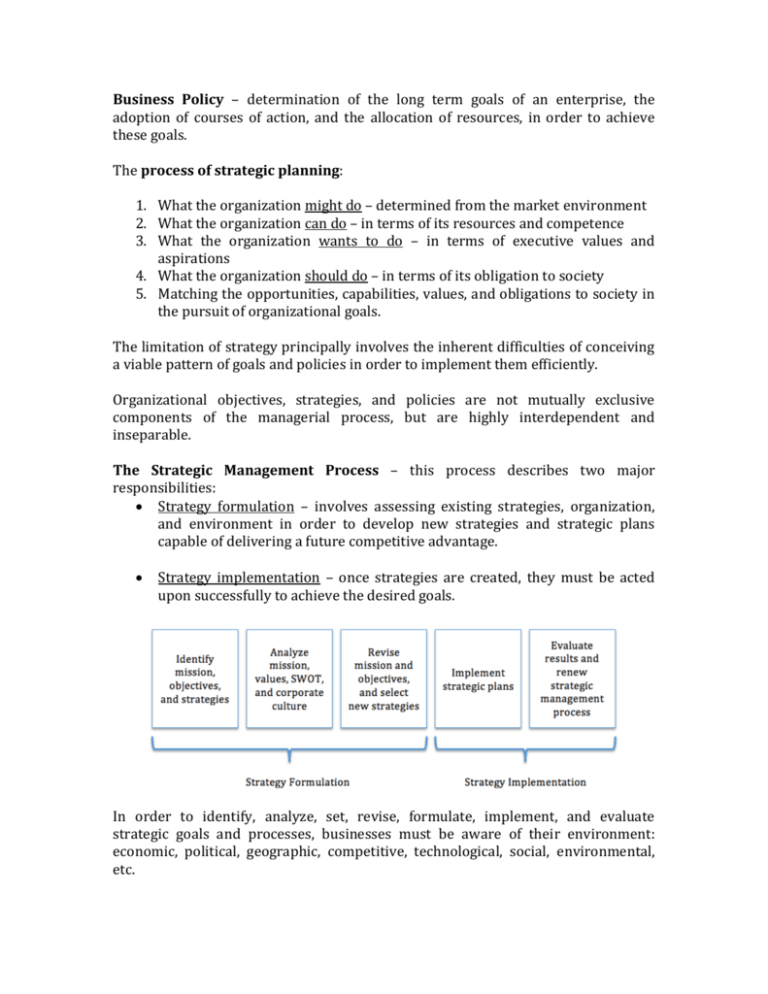
Business Policy – determination of the long term goals of an enterprise, the adoption of courses of action, and the allocation of resources, in order to achieve these goals. The process of strategic planning: 1. What the organization might do – determined from the market environment 2. What the organization can do – in terms of its resources and competence 3. What the organization wants to do – in terms of executive values and aspirations 4. What the organization should do – in terms of its obligation to society 5. Matching the opportunities, capabilities, values, and obligations to society in the pursuit of organizational goals. The limitation of strategy principally involves the inherent difficulties of conceiving a viable pattern of goals and policies in order to implement them efficiently. Organizational objectives, strategies, and policies are not mutually exclusive components of the managerial process, but are highly interdependent and inseparable. The Strategic Management Process – this process describes two major responsibilities: Strategy formulation – involves assessing existing strategies, organization, and environment in order to develop new strategies and strategic plans capable of delivering a future competitive advantage. Strategy implementation – once strategies are created, they must be acted upon successfully to achieve the desired goals. In order to identify, analyze, set, revise, formulate, implement, and evaluate strategic goals and processes, businesses must be aware of their environment: economic, political, geographic, competitive, technological, social, environmental, etc. Peter Drucker associates this process with a set of five strategic questions: 1. What is our business mission? 2. Who are our customers? 3. What do our customers consider value? 4. What have been our results? 5. What is our plan? Peter Drucker – Benefits of Strategy Profitability Market share – gaining and holding a specific share of a product market Human talent – recruiting and maintaining a high-quality workforce Financial health – acquiring financial capital and earning positive returns Cost efficiency – using resources efficiently and effectively to lower costs Product quality Innovation Social responsibility The book HARDBALL (Stalk & Lackenbauer) predicts that over the next 10 years, competition will become so fierce that marginal victories and short-term advantages will not be enough to keep companies thriving. Wining will require relentless strategic execution focused on turning competitive advantages into decisive advantages. Hardball strategies: 1. Unleash massive and overwhelming force 2. Exploit anomalies 3. Threaten competitors profits 4. Take it and make it your own 5. Entice competitors into retreat 6. Break industry compromises 7. Hardball mergers and acquisition The GAP Analysis is an approach to provisional planning; whereby managers measure where the company is today (in terms of strategic planning), where the company is going, where does the company want to go, and how the company will get there. From the image bellow we observe that the “gap” is the area between the momentum line (where the firm is going if everything remains constant) and the potential line (where the firm wants to go or could be going). In order to “fill” the planning gap, and go from momentum to potential, mangers must engage in a few (or all) of the following strategies… Improve current operations Develop new products and services Develop new markets Diversify through various investments The Product Market Matrix of business consists of two axis – products and markets – which are divided into two categories – current and new. A SWOT Analysis is an approach to provisional planning by getting at planning issues for the business by (1) interviewing executives, (2) gathering information, (3) using the provisional planning issue form (4) organizing the data by creating the SWOT matrix, and (5) providing feedback to those who were interviewed. This approach takes inventory of executive judgment in an organization by gathering planning issues through selective interviewing of executives. It is based on the assumption that the goals and objectives of an enterprise are best found in the minds of its key executives. Therefore, it’s able to get at the nature of the business in terms of its strengths, weaknesses, opportunities, and threats. An efficient way of recording executive judgments is by using a provisional planning issue form to record each issue raised during the interview. This will provide the interviewee with an organizational tool for sorting out those aspects of a strategic planning program that are specific to the organization. Once the data has been gathered, the next step is to rearrange the data into logical planning units. The premise for assembling planning issues can be visualized by looking at the SWOT matrix. Internal (organization) External (environment) Positive Strengths Opportunities Negative Weaknesses Threats Other points gathered during the interview may fall into logical planning families of marketing, finance, administration, human resources, legal, and so on. These planning issues (which have been grouped into logical planning families) are best visualized along the links of what is known as strategy chain. The links in the chain will usually be determined by the nature of the business and the number of planning families. Porter’s 5 Strategic Forces Model Porter calls this the “industry structure”. The strategic management challenge is to position an organization strategically within its industry, taking into account the implications of forces that make it more or less attractive. An “unattractive” industry is one in which rivalry among competitors is intense, substantial threats exist in the form of possible new entrants and substitute products, and suppliers and buyers are very powerful in bargaining over such things as quality and price. The opposite is true of an “attractive” industry. Porter’s Generic Strategies Framework According to Porter, business-level strategic decisions are driven by two basic factors: 1. Market scope – how broad or narrow the target market is 2. Source of competitive advantage – how will you gain a competitive advantage Cost leadership – where the organization’s resources and attention are directed toward minimizing costs to operate more efficiently than the completion. Differentiation – where the organization’s resources and attention are directed towards distinguishing its products from those of their competitors. Focused cost leadership – where the organization concentrates on one special market segment and tries in that segment to be the provider with lowest costs. Focused differentiation – where the organization concentrates on one special market segment and tries to offer customers in that segment a unique product. Another way to consider the dynamic nature of business strategy formulation is in terms of the product life cycle. This is a series of stages a product or services goes through in the “life” of its marketability in terms of “sales” and “time”: Introduction Growth Maturity Decline The BCG Matrix Stars – high market-share/high-growth – provide large profits through penetration of expanding markets Cash Cows – high market-share/low growth – provide large profits and a strong cash flow Question Marks – low market-share/high-growth – don’t produce much profit but are highly competitive Dogs – low market-share/low-growth – don’t produce much profit and show little potential for future improvements Maslow’s Hierarchy of Needs Maslow divides the pyramid into two areas Motivation and Satisfaction – which includes the top 2 areas Hygiene – which includes the bottom 2 areas McKinsey 7’s for Evaluating Managerial Effectiveness McKinsey’s 7-S framework can be used for examining the “fits” with managerial strategy. Shared values – these can be attitudes and business philosophies such as “excellence” or “great customer service”. Strategy – strategic planning process Structure – structure follows strategy Staff – must share the values that fit the structure and strategy Systems – administrative practices, and procedures used to run the firm Skills – organizational capabilities and core competencies Style – particularly of management and how they allocate their time and attention, symbolic actions, leadership skills, etc. The MBO process is an example of a strategic planning process, and represents a practical way of implementing strategy through operational objectives. The marketing concept is a philosophical approach that places your current and prospective customers at center stage with your product and service portfolio as well as your future offerings. It’s about how an organization can “get” and “keep customers”. It’s about how an organization can solve its customer’s problems. The marketing concept was officially developed as a result of the industrial revolution. The concept’s basic premise of determining the needs and wants of target markets and delivering on those needs and wants with products and services. This concept also includes the effective communication of a products: o Features, o Benefits, and o Value to current customers The Birthday Party Phenomenon – the evolution of a product moving to an experience consists of 4 stages: 1. Commodity stage – parents go to store and purchase ingredients for cake and make the cake. 2. Good stage – use pre-made ingredients to make cake 3. Service stage – buy a pre-made cake 4. Experience stage – outsource the party completely to venues Starbucks is a prime example of an “experience stage” service industry, where cups of coffee are over twice as expensive as a home brewed coffee, however, Starbucks offers an “experience” to buying their coffee: the lounge, free wifi, etc. Other examples are Harley, Curves, MLB Games, Under Armour, etc.
